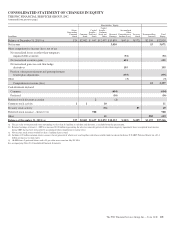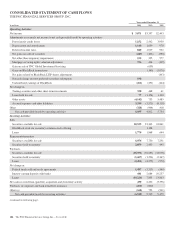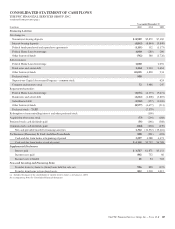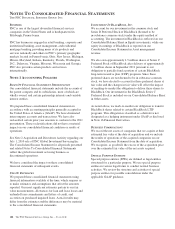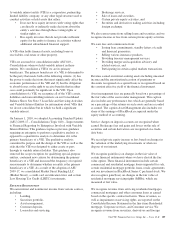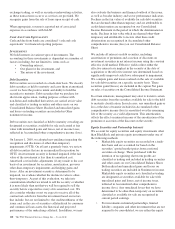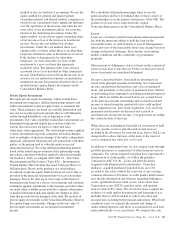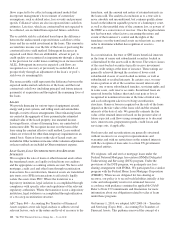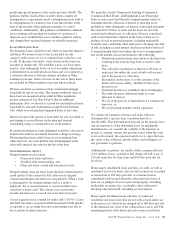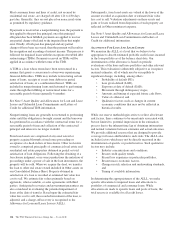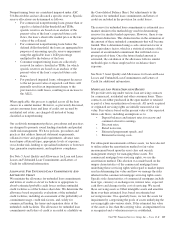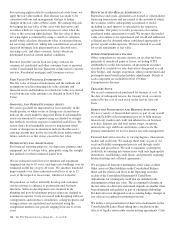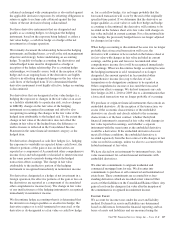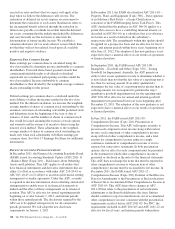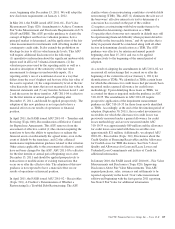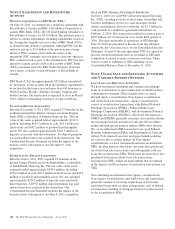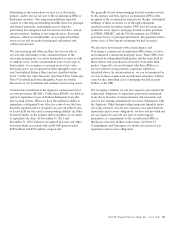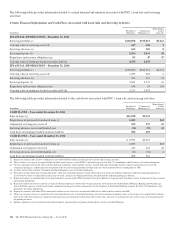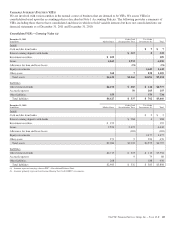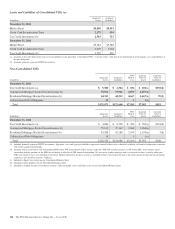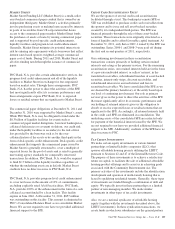PNC Bank 2011 Annual Report Download - page 124
Download and view the complete annual report
Please find page 124 of the 2011 PNC Bank annual report below. You can navigate through the pages in the report by either clicking on the pages listed below, or by using the keyword search tool below to find specific information within the annual report.Nonperforming loans are considered impaired under ASC
310-Receivables and are allocated a specific reserve. Specific
reserve allocations are determined as follows:
• For commercial nonperforming loans greater than or
equal to a defined dollar threshold and TDRs,
specific reserves are based on an analysis of the
present value of the loan’s expected future cash
flows, the loan’s observable market price or the fair
value of the collateral.
• For commercial nonperforming loans below the
defined dollar threshold, the loans are aggregated for
purposes of measuring specific reserve impairment
using the applicable loan’s LGD percentage
multiplied by the balance of the loan.
• Consumer nonperforming loans are collectively
reserved for unless classified as TDRs, for which
specific reserves are based on an analysis of the
present value of the loan’s expected future cash
flows.
• For purchased impaired loans, subsequent decreases
to the net present value of expected cash flows will
generally result in an impairment charge to the
provision for credit losses, resulting in an increase to
the ALLL.
When applicable, this process is applied across all the loan
classes in a similar manner. However, as previously discussed,
certain consumer loans and lines of credit, not secured by
residential real estate, are charged off instead of being
classified as nonperforming.
Our credit risk management policies, procedures and practices
are designed to promote sound lending standards and prudent
credit risk management. We have policies, procedures and
practices that address financial statement requirements,
collateral review and appraisal requirements, advance rates
based upon collateral types, appropriate levels of exposure,
cross-border risk, lending to specialized industries or borrower
type, guarantor requirements, and regulatory compliance.
See Note 5 Asset Quality and Allowances for Loan and Lease
Losses and Unfunded Loan Commitments and Letters of
Credit for additional information.
A
LLOWANCE
F
OR
U
NFUNDED
L
OAN
C
OMMITMENTS
A
ND
L
ETTERS
O
F
C
REDIT
We maintain the allowance for unfunded loan commitments
and letters of credit at a level we believe is appropriate to
absorb estimated probable credit losses on these unfunded
credit facilities as of the balance sheet date. We determine the
allowance based on periodic evaluations of the unfunded
credit facilities, including an assessment of the probability of
commitment usage, credit risk factors, and, solely for
commercial lending, the terms and expiration dates of the
unfunded credit facilities. The allowance for unfunded loan
commitments and letters of credit is recorded as a liability on
the Consolidated Balance Sheet. Net adjustments to the
allowance for unfunded loan commitments and letters of
credit are included in the provision for credit losses.
The reserve for unfunded loan commitments is estimated in a
manner similar to the methodology used for determining
reserves for similar funded exposures. However, there is one
important distinction. This distinction lies in the estimation of
the amount of these unfunded commitments that will become
funded. This is determined using a cash conversion factor or
loan equivalency factor, which is a statistical estimate of the
amount of an unfunded commitment that will fund over a
given period of time. Once the future funded amount is
estimated, the calculation of the allowance follows similar
methodologies to those employed for on-balance sheet
exposure.
See Note 5 Asset Quality and Allowances for Loan and Lease
Losses and Unfunded Loan Commitments and Letters of
Credit for additional information.
M
ORTGAGE
A
ND
O
THER
S
ERVICING
R
IGHTS
We provide servicing under various loan servicing contracts
for commercial, residential and other consumer loans. These
contracts are either purchased in the open market or retained
as part of a loan securitization or loan sale. All newly acquired
or originated servicing rights are initially measured at fair
value. Fair value is based on the present value of the expected
future cash flows, including assumptions as to:
• Deposit balances and interest rates for escrow and
commercial reserve earnings,
• Discount rates,
• Stated note rates,
• Estimated prepayment speeds, and
• Estimated servicing costs.
For subsequent measurements of these assets, we have elected
to utilize either the amortization method or fair value
measurement based upon the asset class and our risk
management strategy for managing these assets. For
commercial mortgage loan servicing rights, we use the
amortization method. This election was made based on the
unique characteristics of the commercial mortgage loans
underlying these servicing rights with regard to market inputs
used in determining fair value and how we manage the risks
inherent in the commercial mortgage servicing rights assets.
Specific risk characteristics of commercial mortgages include
loan type, currency or exchange rate, interest rates, expected
cash flows and changes in the cost of servicing. We record
these servicing assets as Other intangible assets and amortize
them over their estimated lives based on estimated net
servicing income. On a quarterly basis, we test the assets for
impairment by categorizing the pools of assets underlying the
servicing rights into various strata. If the estimated fair value
of the assets is less than the carrying value, an impairment loss
is recognized and a valuation reserve is established.
The PNC Financial Services Group, Inc. – Form 10-K 115


